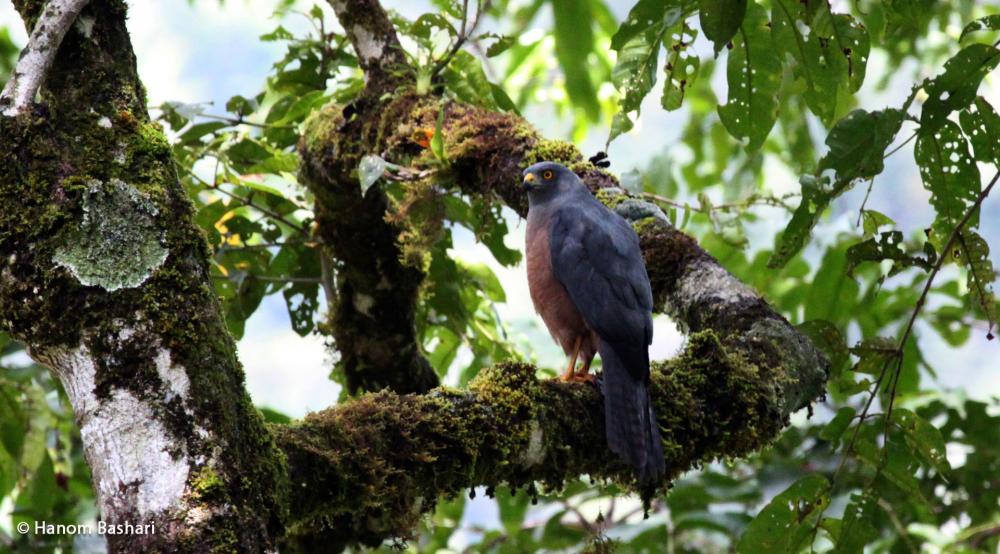| Citation |
|
Description |
Geographic Range [top]
Range Description: Accipiter henicogrammus is found on the islands of Morotai, Halmahera and Bacan (at least), Indonesia (Ferguson-Lees and Christie 2001).
Countries occurrence:
Native:
Indonesia
Additional data:
? Continuing decline in area of occupancy (AOO): Unknown
? Extreme fluctuations in area of occupancy (AOO): No ? Estimated extent of occurrence (EOO) - km2: 58700
? Continuing decline in extent of occurrence (EOO): Unknown ? Extreme fluctuations in extent of occurrence (EOO): No
? Continuing decline in number of locations: Unknown
? Extreme fluctuations in the number of locations: No
? Upper elevation limit (metres): 1300
Range Map: Click here to open the map viewer and explore range.
Population [top]
Population: A survey of Aketajawe Lolobata National Park in 2012 resulted in a population estimate of 2,900 individuals (Bashari 2012) for an area totalling 1673km2: assuming 20% of the EOO (22800km2) is suitable habitat for the species this indicates an approximate total population of approximately 8,000 individuals. Therefore the population is estimated to number 2,500-9,999 individuals, rounded to 1,500-7,000 mature individuals.
Trend Justification: The population is suspected to be in decline owing to on-going habitat destruction (Ferguson-Lees and Christie 2001). Vetter (2009) used remote sensing techniques to track the rate and spatial pattern of forest loss in the North Maluku Endemic Bird Area between 1990 and 2003, and project rates of deforestation over three generations for restricted range bird species found in this region, with consequent recommendations for category changes on the IUCN Red List. This study estimated the rate of forest loss within the geographic and elevation range of Moluccan Goshawk to be c.20% between 1990 and 2003, and projected the loss of c.36% of forest in its range over three generations (estimated by BirdLife to be c.22 years, based on an estimated generation length of c.7.2 years). However, it may be tolerant of some habitat modification, and it is found at higher elevations, where forest is expected to be comparatively more secure, perhaps buffering its population against the impacts of projected forest loss throughout its geographic range, thus the population decline is suspected to be 25-29% over 22 years, from 2004 until 2026.
Current Population Trend: Decreasing
Additional data:
? Number of mature individuals: 2500-9999 ? Continuing decline of mature individuals: Yes
? Extreme fluctuations: No ? Population severely fragmented: No
? Continuing decline in subpopulations: Unknown
? Extreme fluctuations in subpopulations: No ? All individuals in one subpopulation: No
? No. of individuals in largest subpopulation: 1-89
Habitat and Ecology [top]
Habitat and Ecology: The species inhabits hill and mountain forest and forest edge from sea-level to 1,300 m, mostly above 200 m (Ferguson-Lees and Christie 2001). Occasionally the species is encountered in secondary or degraded forest (H. Bashari in litt. 2016), but during a survey of Aketajawe Lolobata National Park all records were from primary forest (Bashari 2012).
Systems: Terrestrial
Continuing decline in area, extent and/or quality of habitat: Unknown
Generation Length (years): 7.2
Movement patterns: Not a Migrant
Threats [top]
Major Threat(s):
The primary threat to the species is habitat loss through commercial logging for timber, and clearance for shifting agriculture, mining, settlements and plantations of coconut, clove, nutmeg and timber species (Vetter 2009, Hanom Bashari in litt. 2016). North Maluku province is undergoing a phase of rapid development which is the driver for the current rate of conversion of forest to agriculture within the range of the species (Burung Indonesia in litt. 2014). Another potential threat is posed by wildfires, which have devastated areas on other Indonesian islands, with the chances of such fires being increased by the conversion of forest to scrub and grassland and the opening up of forests for road construction, as well as selective logging and fragmentation (Vetter 2009).
Conservation Actions [top]
Conservation Actions: Conservation Actions Underway
There are no targeted conservation actions known for this species, although it occurs in Aketajawe Lolobata National Park (Bashari 2012).
Conservation Actions Proposed
Assess the species s population size. Conduct regular surveys to monitor the population trend. Track rates of habitat loss through regular studies of satellite images. Increase the area of suitable habitat with protected status.
Citation: BirdLife International. 2016. Accipiter henicogrammus. The IUCN Red List of Threatened Species 2016: e.T22695544A93514759. http://dx.doi.org/10.2305/IUCN.UK.2016-3.RLTS.T22695544A93514759.en. Downloaded on 06 September 2018.
Disclaimer: To make use of this information, please check the .
Feedback: If you see any errors or have any questions or suggestions on what is shown on this page, please provide us with feedback so that we can correct or extend the information provided
|

